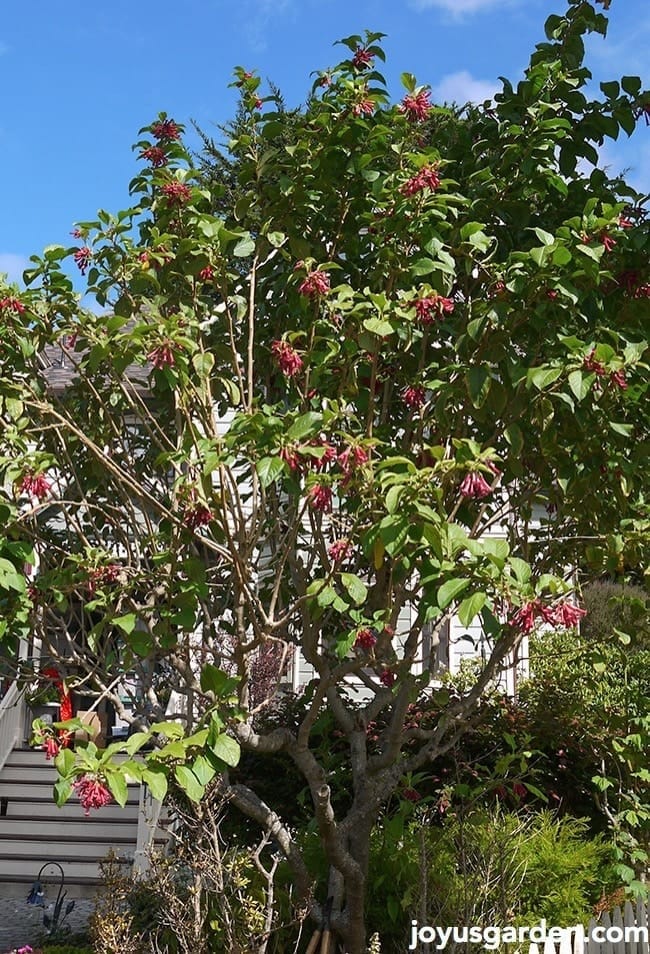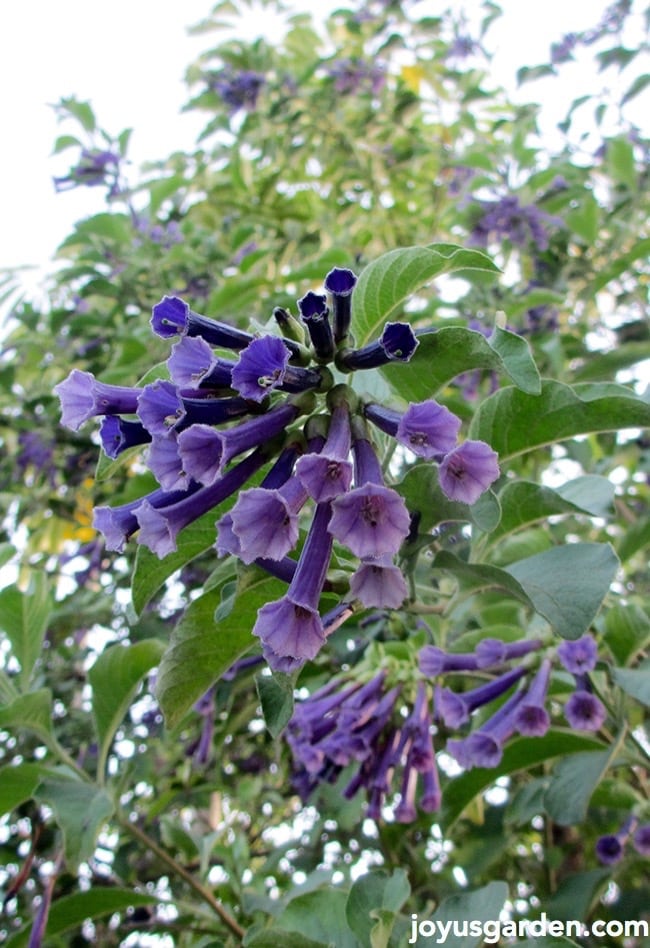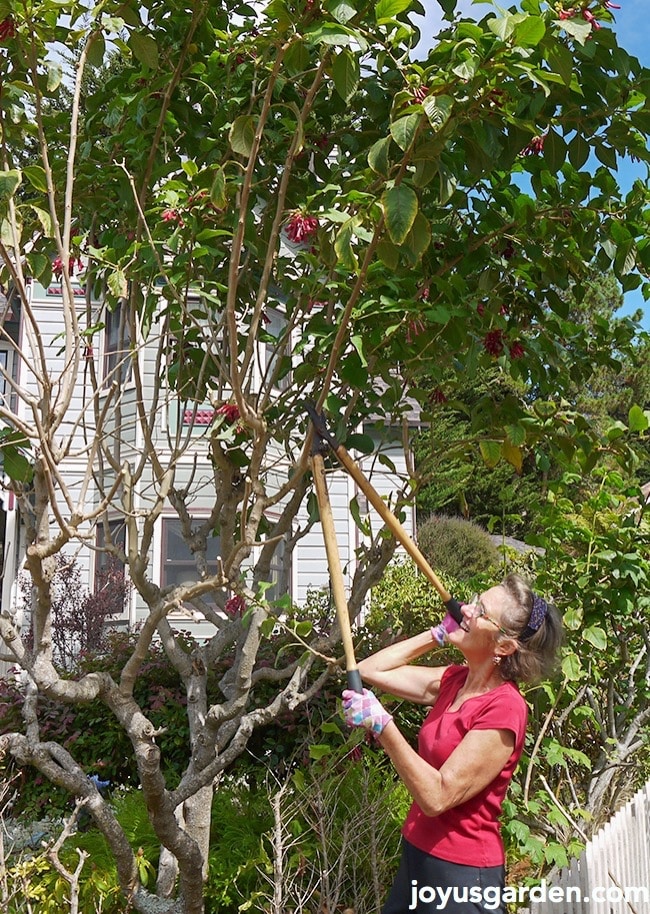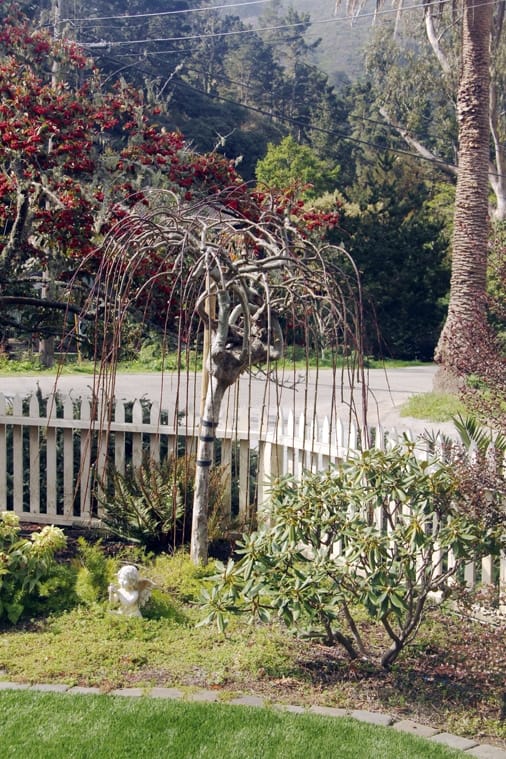How to Care for and Prune an Iochroma cyanea
Oh my tubular floral goodness, Iochroma cynaea grows like a bean stalk and flowers like crazy. Because of its vigorous growth habit, this subtropical stunner needs a frequent cut back. Not only does this tall shrub look much better with pruning but it also stimulates flowering as it blooms on new growth. This is all about the necessary pruning of Iochroma cyanea as well as how to care for it.

Yes indeed, this Iochroma cyanea “burgundy wine” reaches straight up skyward if not given a habitual haircut. It’s hard to believe this was planted out of a 4″ pot. It grew to over 6′ in its 1st season!
As you can well imagine, the hummingbirds go absolutely crazy over these flowers and flock to it every morning and then again in the late afternoon. There is also a blue Iochroma in this garden so when the burgundy one is cut back, then they can buzz over to that 1. I never cut them back at the same time otherwise there would have been a hummingbird coup and I would have been the unhappy victim.
How to Care for Iochroma cyanea
Size
Plainly put, Iochromas grow very fast. The ones that I’ve seen around Santa Barbara & in the San Francisco Bay Area all reached over 12′ tall. They can get a spread of at least 7′. I like to keep them at about 8-9′ tall because they’re much more manageable. Even though they’re classified as shrubs, all the ones I’ve seen have grown into small trees. And remember, it’s the frequent pruning that encourages all that wonderful flowering.
Exposure
Along the coast, they can take full sun (which is considered to be “cool sun”). Be sure to protect them from full sun & reflected heat if yours are growing inland. Indoors, you want to give them as much natural light as possible.
Water
Iochromas like regular water. The 1 that you see here is on drip but is not receiving as much water as it had in past years due to California’s drought. The foliage looks a little paler & smaller than in its glory days but it flowers like the dickens none the less. If yours is growing in a container, don’t let it dry out.

Here’s a purple/blue Iochromas – this 1 is a bit paler but some of the varieties are very intense in color.
Hardiness
They’re hardy to around 25 degrees F. If hit with a 2 or 3 day period of frost, the foliage will drop but the plant will probably recover in spring. If your Iochroma is not too big, it can be brought indoors in the winter.
Fertilizer
The Iochromas growing in this garden don’t get any fertilizer but they do get a generous dose of organic, local composting (a top layer of 2-3″) every year or 2 in the winter. As a container plant, fertilizing is necessary & you want to use a balanced organic food like 10-10-10. Oh, be careful not to use a fertilizer with too much nitrogen.
Pests
Yup, Iochromas certainly get them. The whitefly has been the common insect issue on the 2 in this garden but they have also gotten a few thrips too. These plants grow along the coast just south of San Francisco where the temps are never too hot or too cold – ideal breeding conditions for various pests. When I was the gardener here, I kept the plants thinned in the middle & used sticky traps for both the whitefly & thrips. Keep your eye out for spider mites & aphids too.
Flowers
Not a care tip but this is where Iochroma steals the show (that’s why it’s in capital letters!). In warm climates, it flowers all year long. In the SF Bay Area, they flower spring, summer & fall. The totally tubular flowers reach 3″ long & form a dense ring around the branch. There can be 2 to 4 rings on each branch so when in full regalia, these tropical beauties put on quite the show.
I’ve seen them in blue, purple, burgundy, red, salmon & orange. Hummingbirds adore them & so do bees & butterflies. By the way, they’re related to another flowering machine that’s also in the Solanaceae family – the showy Brugmansias.

I always have to haul out the big girl pruners when pruning this baby!
How to Care for Iochroma Cyanea
I used to be the full-time gardener at this account & pruned the Iochromas 3 times a year for at least 15 years. The current gardener isn’t keeping up on the pruning so that’s why it got so tall & had to be so severely cut back.
When to Prune
I would give them their heaviest pruning sometime in October. You don’t want to prune them too close to when the temps start to drop.
In spring, I would follow that up with a lighter pruning. In mid-summer, they would get a similar pruning. By keeping up with it this way the Iochromas would look a lot better (that fast growth habit turns the plants lanky in no time) & abundantly flower.
You don’t need to be too fussy with the pruning technique. I would start by thinning out & taking down the outer branches. I would prune my way around & inside the plant so that it’s brought down & opened up. As I go, I remove any dead or crisscrossing branches.
By opening Iochromas up in this climate the air circulation is increased which in turn decreases the chance of an in insect infestation. Most grow densely so it’s also good to let some light into the garden below – an added bonus.
There might be some shoots coming off of the base so be sure to remove them.

A bit bare but this Iochroma really needed a good pruning. As you can see, the inner branches are a wee bit taller than the outer ones. I was in this garden 9 months later & it had grown to over 12′ tall once again. The gardener obviously isn’t keeping on top of the pruning!
Iochroma Cyanea Care
The care is easy on these plants if you keep up with the pruning. Iochromas bring new meaning to the term “flower power” and will keep all the hummers and butterflies who frequent your garden well-fed. This dramatic beauty satisfies all!
Happy gardening,


Those taller branches that we pruned out were towering over me!
YOU MAY ALSO ENJOY:
- Things You Need To Know About Bougainvillea Plant Care
- Bougainvillea Pruning Tips: Everything You Need To Know
- Bougainvillea Winter Care Tips
This post may contain affiliate links, you can read our policies here.
- About the Author
- Latest Posts
Nell, the founder of Joy Us garden, was born into a gardening family and grew up in Connecticut’s countryside. After living in Boston, New York, San Francisco, & Santa Barbara, she now calls the Arizona desert home. She studied horticulture & garden design, working in the field all her life. Nell is a gardener, designer, blogger, Youtube creator, & author. She’s been gardening for a very long time & wants to share what she’s learned with you.








Thanks, Nell. I live in the East and my blue is kept in a pot and wintered inside. It is relatively small still and I’ve only had it two years but I’ve upotted it two inches each spring. I’ve grown concerned about it as this winter it seems to want to go dormant, which seems to be the norm from your one photo. So I’m going to run with that and hope for the best come spring. Thanks for all your suggestions and photos.
Hi Nancy – Yes, they tend to loose some of their leaves & look raggedy in the winter, depending on the temps. I’ve never grown 1 indoors but imagine it would go through an adjustment period in winter. Yes, let it do its thing right now & I’m sure it’ll come back for you. These plants are actually pretty tough! Nell
Great videos! I’ve been buying a purple one as an annual at a local nursery for the last 3 years. I often wondered if it was more of a shrub and considered bringing it in for the winter as I’m in zone 5. It breaks my hart every year to see it die. :0( I found an online nursery in California that sells other colors! I am going to buy them and overwinter them in the house. I have very good plant lighting that will be good for them. I grow them in pots and keep them trimmed but it still gets to be around 5 feet. Can I propagate the cuttings from pruning this plant?
Hi Lisa – Thank you! Yes, there are quite a few colors & shades of Iochroma. It grows very fast in coastal California & requires regular pruning. It can certainly be propagated from stems cuttings. Just be sure to use the fresh, softer green tips & not the hardwood. Nell
Hi there – -thanks for your site. I have three small ones (planted last summer in coastal ca). The leaves are looking eaten/raggedy. Since the plants are still new (less than a year) and look more like penstemons at this stage — how much should I prune or trim? Thanks!
Hi Deb – The leaves look “raggedy” after the cool weather. Also, they get torn in areas with a lot of wind. Sounds like they’re very small – only a foot or so tall. Leave them be for now & prune them if you need to during the summer months. I give the one you see here at least 1 good pruning a year. They grow fast once established. Nell
I just purchased one in a four inch pot. I have it in a large container on my back deck, which gets only morning sun but can get hot in the 90’s in the afternoon. while it is in the shade. Any thoughts about this and any special needs for the first year?
Thank you
Hi Mark –
The burgundy Iochroma you see in this post was planted from a 4″ pot & has grown like crazy. It sounds like the exposure you have it in is fine.
It doesn’t like to go bone dry, doesn;t like hot afternoon sun, likes good drainage & soil on the slightly acidic side.
When I planted this one, I put plenty of compost in the hole & watered it well. Don’t let it dry out & top it with compost every year.
Be sure to prune it a bit after flowering the 1st year or 2. It suddenly takes off & then you’ll probably have to prune aggressively. Nell
Wow! So incredibly beautiful! I planted one last summer that was about a foot tall. I’m in Houston and between the torrential rain from Harvey and the unusual freezes we had this last winter, I was pleasantly surprised when I saw little bits of green emerging near the frozen brown sticks. It just now reached a foot tall, but I wonder if I have it planted in the right location? It’s in a raised bed which tends to dry out quick in the Texas sun. It is protected from the harsh sun yet receives dappled sun from the mid size oak over it. I wonder if it would do better in a spot with early morning sun but afternoon shade? Those high 90 -100 degree bright hot & humid days can be too much for some plants. What are your thoughts?
Hi Beck – I lived in San Francisco, moved to Santa Barbara & recently moved to Tucson. The sun here is so much different than along the CA coast so I know what you mean. I love these plants & my the one you see pictured here is still going strong. It grows on the coast 15 miles south of SF – very different from your climate. This plant does best when it doesn’t dry out & doesn’t get any hot sun. The humidity won’t harm it (it’s native to the forests of S.America) but the hot sun will. Nell